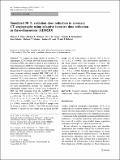| dc.contributor.author | Chen, Marcus Y. | en_US |
| dc.contributor.author | Steigner, Michael L. | en_US |
| dc.contributor.author | Leung, Steve W. | en_US |
| dc.contributor.author | Kumamaru, Kanako K. | en_US |
| dc.contributor.author | Schultz, Kurt | en_US |
| dc.contributor.author | Mather, Richard T. | en_US |
| dc.contributor.author | Arai, Andrew E. | en_US |
| dc.contributor.author | Rybicki, Frank J. | en_US |
| dc.date.accessioned | 2014-02-18T18:12:01Z | |
| dc.date.issued | 2013 | en_US |
| dc.identifier.citation | Chen, Marcus Y., Michael L. Steigner, Steve W. Leung, Kanako K. Kumamaru, Kurt Schultz, Richard T. Mather, Andrew E. Arai, and Frank J. Rybicki. 2013. “Simulated 50 % radiation dose reduction in coronary CT angiography using adaptive iterative dose reduction in three-dimensions (AIDR3D).” The International Journal of Cardiovascular Imaging 29 (5): 1167-1175. doi:10.1007/s10554-013-0190-1. http://dx.doi.org/10.1007/s10554-013-0190-1. | en |
| dc.identifier.issn | 1569-5794 | en |
| dc.identifier.uri | http://nrs.harvard.edu/urn-3:HUL.InstRepos:11717669 | |
| dc.description.abstract | To compare the image quality of coronary CT angiography (CTA) studies between standard filtered back projection (FBP) and adaptive iterative dose reduction in three-dimensions (AIDR3D) reconstruction using CT noise additional software to simulate reduced radiation exposure. Images from 93 consecutive clinical coronary CTA studies were processed utilizing standard FBP, FBP with 50 % simulated dose reduction (FBP50 %), and AIDR3D with simulated 50 % dose reduction (AIDR50 %). Signal-to-noise ratio (SNR) and contrast-to-noise ratio (CNR) were measured within 5 regions-of-interest, and image quality for each reconstruction strategy was assessed by two independent readers using a 4-point scale. Compared to FBP, the SNR measured from the AIDR50 % images was similar or higher (airway: 38.3 ± 12.7 vs. 38.5 ± 14.5, p = 0.81, fat: 5.5 ± 1.9 vs. 5.4 ± 2.0, p = 0.20, muscle: 3.2 ± 1.2 vs. 3.1 ± 1.3, p = 0.38, aorta: 22.6 ± 9.4 vs. 20.2 ± 9.7, p < 0.0001, liver: 2.7 ± 1.0 vs. 2.3 ± 1.1, p < 0.0001), while the SNR of the FBP50 % images were all lower (p values < 0.0001). The CNR measured from AIDR50 % images was also higher than that from the FBP images for the aorta relative to muscle (20.5 ± 9.0 vs. 18.3 ± 9.2, p < 0.0001). The interobserver agreement in the image quality score was excellent (κ = 0.82). The quality score was significantly higher for the AIDR50 % images compared to the FBP images (3.6 ± 0.6 vs. 3.3 ± 0.7, p = 0.004). Simulated radiation dose reduction applied to clinical coronary CTA images suggests that a 50 % reduction in radiation dose can be achieved with adaptive iterative dose reduction software with image quality that is at least comparable to images acquired at standard radiation exposure and reconstructed with filtered back projection. | en |
| dc.language.iso | en_US | en |
| dc.publisher | Springer Netherlands | en |
| dc.relation.isversionof | doi:10.1007/s10554-013-0190-1 | en |
| dc.relation.hasversion | http://www.ncbi.nlm.nih.gov/pmc/articles/PMC3701132/pdf/ | en |
| dash.license | LAA | en_US |
| dc.subject | Coronary imaging | en |
| dc.subject | Computed tomography | en |
| dc.subject | Angiography | en |
| dc.subject | Image reconstruction | en |
| dc.subject | Radiation dose | en |
| dc.title | Simulated 50 % radiation dose reduction in coronary CT angiography using adaptive iterative dose reduction in three-dimensions (AIDR3D) | en |
| dc.type | Journal Article | en_US |
| dc.description.version | Version of Record | en |
| dc.relation.journal | The International Journal of Cardiovascular Imaging | en |
| dash.depositing.author | Steigner, Michael L. | en_US |
| dc.date.available | 2014-02-18T18:12:01Z | |
| dc.identifier.doi | 10.1007/s10554-013-0190-1 | * |
| dash.contributor.affiliated | Steigner, Michael | |
| dash.contributor.affiliated | Rybicki, Frank John | |


